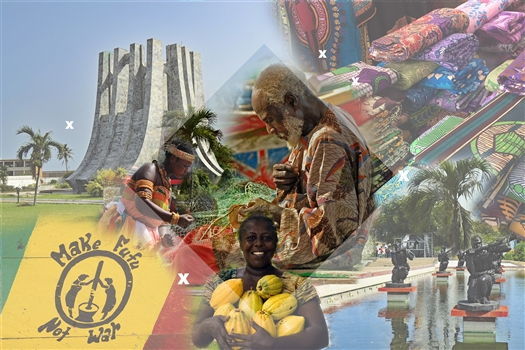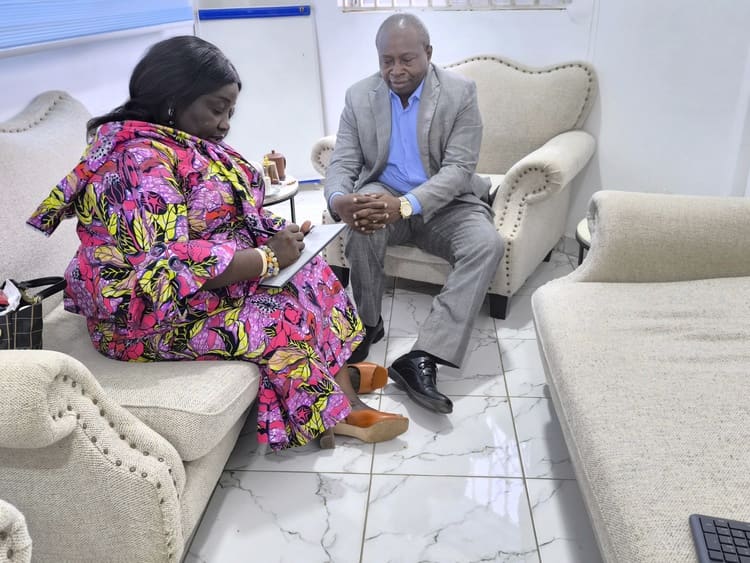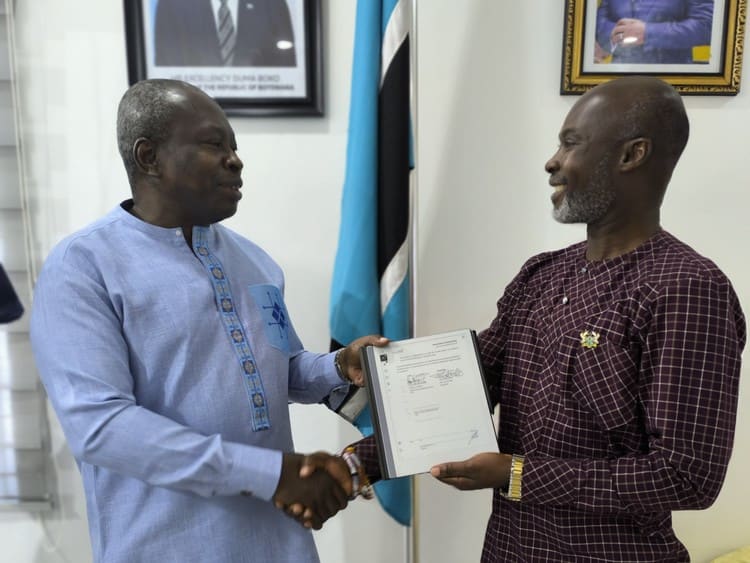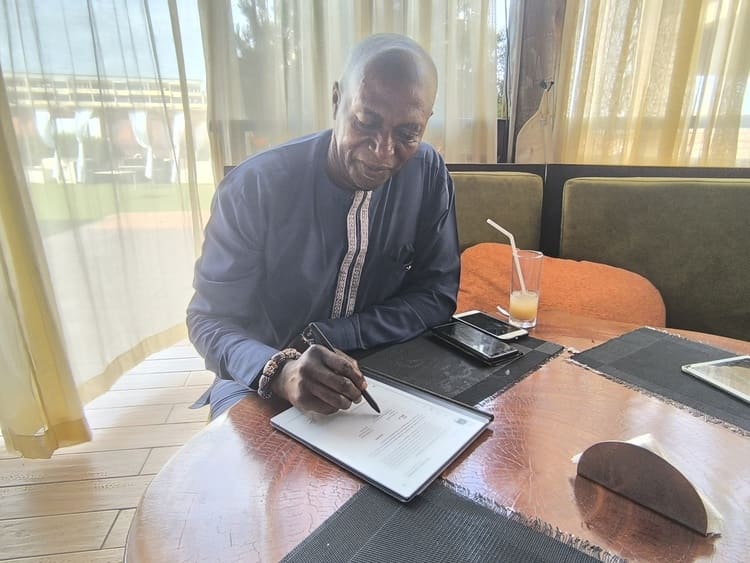A Vibrant Celebration of Unity and Heritage in Elmina, Ghana
The Edina Bakatue Festival is an annual celebration that takes place in Elmina, the heart of the Edina Traditional Area, also known as Edinaman. Annually, on the first Tuesday of July, the festival weaves together the past, present, and future of the Elmina people in a vibrant array of events. Experience the Bakatue Festival, where every ritual, dance, and drumbeat echoes the soul of Ghana and Elmina.
What is the Edina Bakatue Festival about?
Embedded in the vibrant culture of Elmina, a Ghanaian coastal town, is the Bakatue Festival - an annual event that transcends joyous celebration. It’s a living legacy of the community’s rich heritage, unity, and reverence for nature and the divine. From the grand durbar of chiefs to the vibrant processions, rhythmic drumming, and captivating traditional dances, every aspect of the Bakatue Festival is a spectacle to behold. It is an interesting narrative of a community that takes immense pride in its customs, values, and identity.
Symbolising Unity and Heritage
For the Elmina people, the Bakatue Festival is a symbol of unity and a celebration of their shared history, also signifying the start of the fishing season. This highlights the community’s deep-rooted connection to their natural surroundings and the sea, the cornerstone of their economy.
Paying Homage to the Divine
The festival is also a way for the people to pay homage to their deity, Nana Benya, the river deity that protects them and ensures a bountiful fishing season. This spiritual aspect of the festival underscores the community’s profound reverence for their deities and the role they play in their daily lives.
Resilience Personified
Above all, the Bakatue Festival is a testament to the resilience and indomitable spirit of the Elmina people. The community has preserved this centuries-old tradition, ensuring its continuity for future generations. This celebration is, therefore, not only about their past but also a vibrant celebration of their present and a salute to their future.
The Origins of the Edina Bakatue Festival
"Bakatue" originating from the Fante dialect, signifies "the opening of the lagoon". Yet, the festival’s essence transcends its literal meaning. It’s a celebration of unity and the deity Nana Benya, and a testament to the enduring spirit of the Edinaman area.
Legends state that the founder of Elmina, Kwa Amankwa, migrated from the Savana-based Walata Empire and eventually arrived in Elmina. In his quest for potable water, he stumbled upon a small stream, exclaiming, "Be-enya", which translates to "I have found or got".
The Covenant Between Man and Deity
In remembrance of this discovery, Kwa Amankwa built a modest shrine where the settlers rejuvenated. Kwa Amankwa paid his respects for the blessing, and in solemn silence, a divine entity appeared before him. The river deity Nana Benya interacted with Amankwa for eight days, at the end of which they formed an agreement - a covenant. This spiritual event is what further solidified the foundations of the Bakatue Festival.
Conditions of the covenant were:
- Amankwa was to build a shrine honouring Nana Benya, serving as a sanctified dwelling for the patron deity, invoked in times of need.
- A lunar-based schedule determined the first Tuesday of each July as the annual festival day, marking the unique man-deity encounter.
On this day, everyone, from the Omanhene (title of the supreme traditional ruler or 'king'), chiefs, priests, and the public, would present sacred food offerings (yam, palm oil, and eggs) to the river god.
These practices have withstood the test of time, and the annual meeting between the deity and the people of Edinaman has remained a vital aspect of the Bakatue Festival. The Shrine's location is different now, but it still stands in its new location, like a beacon steadfast in its purpose. The god's presence within it is as vibrant as ever. The terms of the ancient covenant still resonate, whispering promises of divine guidance: "In this sacred space, we shall meet, at the very least, once each year. Here, in times of need, you may call upon me".
Activities and Traditions of the Edina Bakatue Festival
The Bakatue Festival is filled with various preparation activities and traditions that showcase the unique cultural symbolisms and build up the momentum for the major celebration.
The Significance of Tuesday at the Bakatue Festival
This day of the week is no random choice; rather, it has profound historical and cultural implications. Tuesday, in the Akan tradition, is a sacred day. It is associated with peace, tranquillity, and purity, attributes directly connected with the river deity, Nana Benya. Tuesday is a day of beginnings. As per the covenant between the founder, Kwa Amankwa, and Nana Benya, the first Tuesday of July every year marks the main festival day. This event sets off a new relationship between the people and their deity and the onset of a new fishing season. Tuesday has become a bridge between the Elmina people’s cultural heritage and their spiritual beliefs, uniting them in the vibrant celebration of the Bakatue Festival. It also serves as a reminder of their historical origins and their enduring bond with Nana Benya.
The 6-Week preparations
In the six weeks leading up to the Bakatue Festival, the community of Elmina transforms into a vibrant hive of activities. These preparations are as crucial as the festival itself, setting the stage for the grand spectacle that is to follow. Some restrictions prohibit net fishing in the lagoon or selling fish in the market.
A significant aspect of these preparatory activities revolves around purification. Six weeks prior to the celebrations, the community cleans up the town. This involves sweeping and tidying the streets, homes, and the marketplaces, symbolising the removal of negative energy and making way for prosperity and positivity. This is also when a six-week quiet period begins. During this time, noise making, drumming, singing, and dancing is banned. The 'quiet period' before the main festival day creates an atmosphere of anticipation and even deeper respect for the upcoming festival.
Final Preparations
As the festival nears, the town witnesses a flurry of all kinds of preparations. Locals paint their canoes in vibrant colours, prepare their traditional attire, and the aroma of special dishes wafts through the air. There’s a noticeable sense of excitement as the community prepares to celebrate.
The meticulous and elaborate preparations for the Bakatue Festival are a testament to the deep-seated reverence the Elmina people have for their culture and traditions. Each activity, from the purification rituals to the capping of the shrine, reflects their commitment to preserving their heritage, making the Bakatue Festival a beautiful blend of the past, present, and future.
Every Monday sees a rotation of rituals performed by priests and drummers. The spiritually possessed chief fetish priest performs, responding to spiritual revelations.
Weekly Activities During the Festival
Week 1
Purification of Widows
Following this is the unique ritual for widows. This ceremony leads widows in the town through a purification process. This ‘cleansing’ is necessary to rid them of any bad luck associated with their state of widowhood, ensuring that the entire community enters the new era in a state of purity and takes part in the festival.
Capping the Shrine
One of the most significant pre-festival activities is the Nana Benya’s shrine capping. Locals seal off the shrine, symbolising a period of rest for the deity. The capping serves as a metaphysical boundary, marking the beginning of the quiet phase before the festival erupts into a vibrant celebration. They take off the old shrine’s cap (“Burukutukyew”) and carry it to the sea to be swallowed by the waves and replace it with a new one.
Week 2
Bonfire and "Sosoogya"
On Monday of the second week, youth organise a bonfire to drive away all the ‘bad energies’ of the previous year. On the following day, men symbolically show vulgarity, embarrassing women of childbearing age, as a penance for wrongs and defilement attributed to the women.
Week 3
Retaliation by Women and Wood Platter Overturn by Ankobea Safo
In the third week, tradition mandates the Ankobea Asafo (№.1) to carry out an important ceremony called the Overturn of the Wooden Platter (or ‘Korbabutuw’). This group, known for their strength and spirit, march in an unconventional procession to the Shrine on Monday evening.
Their journey culminates at the shrine. Ankobea Asafo (№.1) performs the overturning of the wooden platter (Korba Butuw) ceremony where they present a sheep to the community. The sheep is a ritual sacrifice to the gods, signifying the official start of a period where all previously mentioned taboos must be strictly observed. The Omanhen (chief) and his elders must be present during this ceremony.
Homecoming of the Deity
At the stroke of midnight on the same Monday, four out of thirteen straw-hat bearers (state courtiers, also known as Birifikyewfo) embark on a journey to “Anwewdo” or the river’s source. Their mission is to invoke and carry the spirit of the god Benya back to the Shrine to seek divine guidance and protection for the nation and community as they transition into a new year. The Royal State drum, known as Aketsewta, sounds fill the air. This sound serves a dual purpose. First, it alerts people to make way for the deity to pass by. Second, it plays a crucial role in the invocation ceremony itself.
The Ritual Offering
Ankobea Asafo ritually slaughters the previously presented sheep on the following Tuesday morning. This ritual involves offering to the gods, pouring libations, and uttering sacred incantations.
Women’s Retribution
On this same Tuesday, women take on the role of symbolic retaliation, wielding “Mpapan” to lightly whip the men they encounter. This ritual represents the community’s stand against immorality among men. Immoral behaviours are viewed as an offence against the entire state’s collective wellbeing.
Week 4
The First “Dombo” Drumming
During the fourth week of preparations, the first of three state drumming sessions, known as “Dombo,” takes place at the sacred shrine’s frontage. As the traditional choristers (Apaafo) and drummers (Tentenfo) gear up, key community figures like the Omanhen, Chiefs, Stool holders, State Courtiers, and citizens gather and prepare to engage in the rhythmic drumming and dancing, consult the oracle. At the right moment, the 77 state gods spiritually descend, guiding the performing priest’s actions. In ancient times, locals believed that the sacred shrine itself danced to the drum’s rhythm.
Week 5
The Second “Dombo” Drumming
The fifth week repeats the traditional drumming and dancing routine, held at the same location, time, and with the same participants. Those who missed the first Dombo can join also the second, although most residents strive not to miss any of these events.
Week 6
“Korbatae” on Monday Evening
Akyemfo Asafo (No.2), with the Eagle emblem, takes the stage in the sixth week. On the eve of the festival, they gather at the Shrine, presenting a sheep as a ritualistic sacrifice. This event, known as “Korbatae,” signals of the end of the six-week taboo period that was started by Ankobea Asafo. Everyone attends this event, even the Omanhen, elders, and state courtiers actively take part.
Monday Vigil
The festival nears its peak with an all-night Dombo drumming session. Priests engage in spirited dancing, each reflecting the unique style of their respective deity. The well-versed observer can discern the dominant god by the priest's dance moves. The echoes of this third and final Dombo drumming guide us into the long-awaited Tuesday morning.
The Red Letter Day - The Main day of the festival
Tuesday marks the pinnacle of the Bakatue Festival, a day of royal grandeur and vibrant ceremonies. At noon, a stunning procession takes place, showcasing local leaders, priests, healers, and dedicated citizens resplendent in traditional attire. The Paramount Chief, the highest authority, appears last. Dressed in white, with a straw hat and sceptre, his outfit, distinct from the golden ornaments of other chiefs, underscores his preeminence. Ensconced in a flamboyant palanquin under a majestic tow-tie umbrella, he embodies supreme command.
The Sacred Rituals
The procession goes through the principal streets of Elmina and halts briefly at the sacred shrine for the final purification ceremonies. A courtier carries a wooden tray, symbolically holding the community’s burdens and curses. Upon reaching the river’s embankment, the Chief Linguist performs the rite of libation, offers food sacrifices, and metaphorically buries all ills and curses in the river.
Lifting of Bans and Unity Display
The Paramount Chief casts his net into the river thrice, each time followed by a gunshot, signifying the lifting of bans on fishing, drumming, funerals, and other restrictions of the past six weeks. The exchange of yarn and fish between Eguafo and Edina highlights the historical unity of these two traditional areas.
The Jubilant Conclusion
The festival culminates in a grand procession ending at the Omanhen’s Palace, accompanied by traditional drumming. During the celebration, the community’s principal leaders and priests sacrifice food to the river spirit and ask for peace. After rituals at the riverside, the chief priest lifts the ban on various social activities by casting his net thrice into the river. The change in the area’s pulse is palpable as the community resumes their activities, which had been paused for 6 weeks in anticipation of the festival.
The Vibrant Show and the Grand Finale
The festival also brings with it a breathtaking spectacle of women, draped in vibrant and colourful “kente cloth” and festive headgears, riding on the lagoon. Their colourful outfit is not only a feast for the eyes but also a sign of the community’s unity and strength. The spectacle of women in ‘kente’ cloth and festive headgears riding on the lagoon, and the royal procession leading to the chief’s palace with traditional music, provide a fitting closure to the festival. The procession marks the conclusion of the festival, yet its influence and the feeling of togetherness it nurtures continue long after the music has dissipated.

Edite Strautmane, travel writer and nature enthusiast, shares her passion for travel, exploration and adventure through stories on GhanaTRVL.










Comments